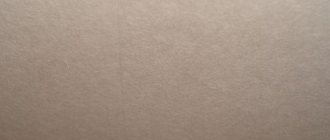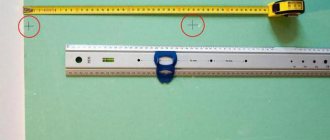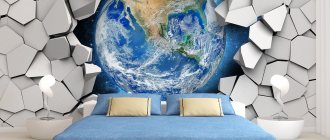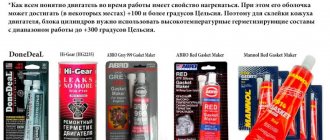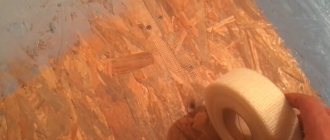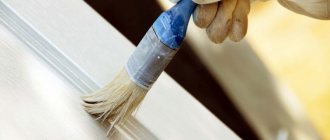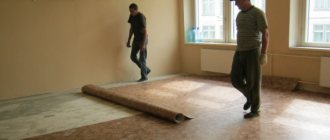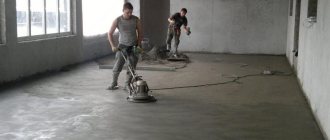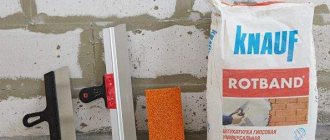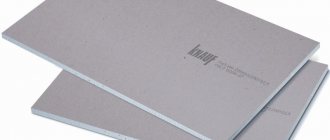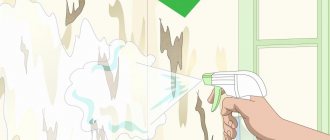Preparing surfaces for finishing work is a difficult and responsible operation, but repairs of any complexity cannot be done without it. Nowadays, new materials are constantly appearing that are designed to make home transformation much easier. This army of “helpers” was recently joined by fiberglass, another name for it is painting web. Fiberglass saves walls and ceilings from cracks, chips, and other unpleasant defects. But in order to provide the surfaces with an ideal appearance, you need to be aware of how to glue fiberglass, what it is, and know everything about its characteristics, advantages and disadvantages.
What is fiberglass?
It is better to find out as much information as possible about any material before starting work, so before gluing fiberglass, you need to get to know it better. This is a painting reinforcing mesh - a non-woven material made entirely of glass fibers of various thicknesses. Their chaotic connection, obtained by pressing, makes it possible to make the surfaces reliable and prevent the formation of cracks.
Organic resins are used as a binder for the production of spider webs, so it is absolutely safe. There are several types of fiberglass, they differ only in density (20-55 g/m2). For indoor work, it is recommended to use certain indicators that do not go beyond the limits - from 30 to 40 g/m2.
There is often some confusion with concepts. Fiberglass is called glass wallpaper, or vice versa. These are two completely different materials. Cobweb is a protective coating, a backing for finishing, wallpaper is decorative, having a certain relief. They also differ in density: in the first it is still small, in the second (the highest quality) it is three times higher. Glass canvas has no patterns or relief, so it can be painted many times; wallpaper can be painted a maximum of 12 times, as their manufacturers believe. Another indicator is the price: a simple spider web is at least half the price.
Color solutions
In order to decide on the color of the wallpaper, you first need to be guided by your own taste preferences.
However, there are some general tips to help you make a choice.
It is not recommended to choose too bright colors for painting. They quickly become boring, can cause irritation, and will interfere with rest and relaxation.
It is better to give preference to neutral, calmer tones. If you want to highlight the walls in an original way, add bright colors to the interior, it is better to highlight them with separate elements, for example, bright patterns on a neutral general background of wallpaper. In this way, you can achieve originality of the room, and also make it visually larger. It is important to pay attention to the combination of wallpaper with furniture in the room. They should complement each other in color, patterns and style.
If you plan to apply designs to the glass wallpaper, you need to maintain harmonious proportions depending on the size of the room. Large details contribute to the visual reduction of space, which is inappropriate in small rooms
A small pattern, on the contrary, is suitable for a small room and will help make it more spacious. It is important to keep in mind what purpose the room itself has, and how harmoniously wallpaper in a particular color will look in it. For the kitchen, colors should not be too bright, dirty, or gloomy
If there is enough natural light, you can choose cool shades: green, blue, gray. If you need to add light to the kitchen, it is better to give preference to warm colors: yellow, pink, orange.
- For living rooms, shades found in nature are suitable: green, pink, yellow. To add originality, you can use stencils to add colored patterns to the walls to suit your taste. For bedrooms, calm colors are suitable that will help you relax and unwind: beige, blue, light green, pink.
- Using different textures and colors, you can highlight one of the walls and divide the room into zones. An interesting solution is to choose the same pattern for different walls, but different in size.
Application areas of canvas
This material is indispensable for finishing work and for the production of building materials. He takes part in the production of:
- aqua panels;
- waterproofing;
- linoleum;
- foam glass;
- printed circuit boards;
- roll roofing;
- glass wool in slabs;
- elements of drainage systems.
- prepare surfaces for wallpaper, painting, drywall, various panels;
- They make waterproofing and anti-corrosion protection of pipelines, combining it with mastics or bitumen.
Using a painting web:
Fiberglass is used as a reinforcing layer, which protects the finishing coating from cracks, shedding and other similar defects. The reverse, fleecy side is almost always on the outside of the roll. The facial one, on the contrary, is ideally smooth; it is often “hidden” inside it.
Examples in the interior
Let’s summarize the article with photographs of glass wallpaper in the decor of various rooms of a residential building.
Glass wallpaper in the kitchen. The canvases are in a soft gray color and with an expressive pattern. White drawing on a gray background.
Gray finishing material in standard gray color for finishing the bedroom.
Relief fabrics in warm peach color. An ideal solution for the bedroom, kitchen, living room and other parts of the house.
Smooth and bright wallpaper in a vibrant blue color. The canvases will decorate a modern interior.
Durable and moisture-resistant glass wallpaper can even be used in bathrooms. Beige canvases fit perfectly into a classic interior.
A stylish and effective combination of embossed photo wallpaper. Colors and textures are in harmony with each other, creating an expressive interior.
More information about glass wallpaper in the next video.
Advantages and disadvantages of cobwebs
Fiberglass is not without strengths and weaknesses in the same way as other colleague materials. Traditionally, people talk about the benefits first, so let’s move straight to their impressive list. Cobweb:
The material can be safely glued to any surface - wood, concrete, brick, plasterboard, ceilings or walls.
There are also disadvantages, these include:
- The ability to “attack” low-quality, inexpensive material with a short service life. Such products will disappoint due to the inconvenience of working with them, inelasticity, and fragility.
- Impossibility of using first grade fiberglass in premises. It contains phenols and formaldehyde resins, which are undesirable components.
- The ineffectiveness of the material if there is a need to hide serious defects - large cracks, chips, potholes. They will have to be sealed in advance.
- The need for protection (gloves, glasses, masks, or better yet, a respirator) when working due to small glass particles.
- Difficult to dismantle the coating.
- High consumption of glue.
One cannot but agree that the disadvantages are still relative, since most of them relate to low-quality products. Therefore, in the “battle” of advantages and disadvantages, the first ones emerge as winners.
Advantages of fiberglass:
- This is one of the most durable wall coverings: it does not scratch, does not tear, is resistant to moisture, their strength qualities are 2-3 times higher than those of vinyl;
- Wallpaper does not attract dust and does not accumulate static electricity;
- Mold or mildew does not grow under them;
- Non-flammable, do not emit toxic substances;
- The gluing technology differs little from the traditional one.
Fiberglass wallpapers are more expensive than non-woven or vinyl counterparts. One of the significant drawbacks is the minimal amount of painting: after 3-4 layers of paint, the texture begins to blur. By the way, only latex or acrylic paint is suitable for this material - it is less dense. And one more thing: glass wallpaper will be difficult to remove from the wall, since they are glued “tightly” as they say.
Adhesive compositions for fiberglass
Before studying the topic of how to glue fiberglass, it is better to get acquainted with the features of adhesive mixtures for it.
Types of adhesive composition
Building materials stores sell 2 types of such compositions: ready-made, packaged in plastic buckets, and dry powders in paper bags.
- Ready-made glue (5, 10 liters or larger volume). When purchasing it, you need to check the manufacturing date on the container. Otherwise, you can purchase expired goods, and the result of the work will be the appearance of bubbles. Another potential problem is peeling of the canvas due to poor adhesion. It is recommended to use open containers in the near future, since there is no guarantee that the composition will not lose its characteristics.
- Dry powder. This is a more practical option, since this type of glue costs less, but allows dosed use - only in the required volume. Prepare glue in strict accordance with the instructions on the package. If there are no other instructions, then pour the powder into warm water, stirring constantly. The prepared composition is kept for about 10-15 minutes, because it must swell. Then the glue is stirred again.
The third possible option is PVA, but with only one condition. Fiberglass has a fairly low density, so the glue will soon turn yellow in the light. This color change will definitely affect the light coating. If the choice fell on PVA, it is better to choose dark colors. However, special mixtures are better: they contain additional additives that give the material maximum strength.
Glass fiber adhesive brands
Since fiberglass can be glued using the same compounds as glass wallpaper, the range to choose from is quite wide. The most popular brands include mixtures of several manufacturing companies.
- Quelyd is a French brand. Under it, a large number of different adhesives for wallpaper, wallpaper removers, sealants and mastics are produced. The most popular product for glass wallpaper is Optima.
- Oscar is a Swedish brand, the compositions are produced in Russia. The glue, ready-made or dry, is characterized by minimal consumption and high strength. Additionally contains fungicides that prevent the formation of mold.
- Kleo is another “French”. This company specializes in the production of dry adhesives for glass wallpaper and fiberglass. The products are distinguished by high quality, but affordable price, quick preparation of the mixture, and the same drying time.
- Pufas is a German candidate for surface repair. The manufacturer produces paint and varnish coatings, adhesives, and primer mixtures. Glass wallpaper products are famous for their excellent adhesive properties.
- Bostik is another brand from France. The company produces various adhesive compositions, but the most famous is the parquet mixture. Despite the low price, adhesive mixtures for canvas guarantee reliable coating and easy joining of canvases.
Other worthy contenders include products from Spektrum (Sweden), Nortex, Wellton, Bolars (Russia).
Folk alternative
There is a recipe that allows you to make a decent adhesive composition with your own hands. To do this, mix:
First, dry glue is mixed with water to obtain a homogeneous composition without lumps. After this, PVA is poured in. This sequence allows you to avoid clots consisting of PVA and dry undiluted powder.
Which option to prefer is up to the owners of the house being renovated to decide. Dry compositions will be cheaper than ready-made mixtures; the cost of homemade glue will be the most affordable; some craftsmen even consider it the best solution for almost all surfaces.
Review of manufacturers
Fiberglass is a popular material. It is produced by many companies that also produce glass wallpaper, fiberglass, and waterproofing materials.
- Vitrulan is a German company that produces fabric with a density from 25 to 300 g/m². On the Russian market it is considered the highest quality durable option: the tensile strength of dense canvas reaches 4.5 tons. However, the company’s products are quite expensive: the lightest “spider webs” cost at least 2,000 rubles per roll.
- Wellton - from a Swedish company. Produces fiberglass in a smaller range of densities, but is strong and durable. It is not recommended to exceed the manufacturer's recommendations: a surface reinforced with too light a mesh will crumble.
- Oscar - a Chinese manufacturer offers low and medium density material. “Gossamer” is affordable, hypoallergenic, and easy to install.
- TechnoNIKOL is a Russian company that produces high-strength fiberglass. They are used in roofing insulation and for reinforcing walls in industrial premises.
- X-Glass is a Russian manufacturer offering high-quality glass interlining. The assortment is small, but attracts with a low price.
- Nortex - the company's factories are located in the Czech Republic and China. The manufacturer produces fiberglass of different densities and at an affordable price.
How to glue fiberglass?
The technology is simple enough not to cause any difficulties. Anyone who knows how the wallpapering process works can easily figure out this operation. In order for the work to proceed without delay, everything necessary is first prepared. This list includes:
To prepare glue from a dry mixture, you will need a bucket, a drill with a mixer attachment, or a small wooden stick (narrow strip). In addition, purchase means for reliable protection against glass in advance - glasses, gloves, a respirator. It is best to wear long sleeves.
Preparatory activities
They, as always, involve preliminary preparation of surfaces.
- They are completely cleaned of the previous coating, then large defects, such as cracks, must be filled with putty. Determine the need for surgery by checking their size. They do this test with a spatula: if the crack is wider than its blade, then it is necessary to fix it.
- When the putty knife refuses to fit into the hole, putty is not needed. The surfaces are cleaned of dust, then the walls (ceilings) are primed with a deep penetration compound or glue not diluted too much with water. Wait for the surfaces to dry.
- The bases are marked according to the dimensions of the sheets, leaving a small allowance for overlapping joints. Use a pencil or marker. The rolls are unrolled with the wrong (rough) side facing up.
Then elements for the ceiling and floor are carefully cut out of fiberglass in accordance with the measurements taken. The size of the canvas can be arbitrary: the one that is more convenient to work with. For walls, they can be cut to their entire height at once; for ceilings there is a limitation: sections exceeding a length of 2 meters are extremely difficult to handle, even for two people. On a horizontal surface, the canvases are placed along the room.
What are the features of this job?
How to glue fiberglass? This operation is not much different from working with wallpaper. Just as with conventional wall materials, there should be no drafts in the room. But the process itself is somewhat simpler due to the fact that the adhesive composition is spread directly onto the bases.
- Apply glue to a section of the wall or ceiling with a roller. Brushes are used in corners and other hard-to-reach places. Glue a piece of web. To avoid the formation of bubbles, the surface is carefully smoothed (“herringbone”) with a wallpaper spatula.
- The excess of the glued canvas, if any, is cut off, then it is impregnated with glue again. The surface is again passed over with a spatula to ensure good impregnation with the composition. The finished sheet should darken slightly.
- The adjacent piece is glued with an overlap, the overlap is from 30 to 40 mm. Then, at the junction of the two canvases, a ruler (or a wide spatula) is applied, along which a cut is made through both layers. Excess tape is removed, and the seam is coated with glue again.
- Do exactly the same thing in the corners. The first sheet is bent by 40-50 mm, the next - in the opposite direction. In the middle (in the corner) the fiberglass is cut, and then the strips are removed.
- Each new canvas and joints must be treated with glue. Its excess is removed with a spatula located almost at a right angle. Remove excess adhesive from the surface with a soft cloth.
In this case, an additional layer of glue acts as a primer, but the application of the original primer before the next operation is still required in most cases. After the surfaces have dried (but not before), you can begin further work, which depends on the chosen finishing coat.
Not all surfaces are covered with this method, the exception being drywall. In this case, the sheets of fiberglass are placed only end-to-end. The reason is the top paper layer of the plasterboard, it is easy to damage, and the defect will inevitably lead to cracking of the gypsum “filling”. There is a way to avoid an emergency - dull the tip of the blade on brick or concrete. Such a knife will not touch cardboard, but will easily cut fiberglass.
Pasting mixture
The glue for the “web” should be selected correctly. It needs a special one, which is designed specifically for this purpose. There is no need to try to save money and use other types of glue. This can lead to consequences that could not be expected.
When choosing glue for fiberglass, you need to make sure that it is intended for gluing this particular material
The glue is applied thickly, but without excess. It is very convenient that if there is not enough glue, and the mesh is already glued, then you can coat it on top - saturate it. The spider web mixture has the following advantages:
- the glue is completely environmentally friendly;
- leaves no stains or marks;
- final setting time – 2 days;
- does not react to cold.
Fiberglass and finishing
The fiberglass sheets are allowed to dry for a day. After this they move on to putty. Sometimes this stage is skipped: the walls or ceilings are painted right away. In this case, the painted surface will have an interesting “web-like structure”.
If the owners do not set such a goal, then leveling with finishing putty is mandatory. It is recommended to apply two thin layers - from 1.5 to 2 mm. Each of them must dry for 12 hours. Then the surfaces are sanded and primed, ensuring a reliable base and better adhesion, which means less material consumption.
The last stage is painting or wallpapering. In the second case, putty is also required, since heavy materials - vinyl, non-woven - do not really like such a surface. They don't stick well to it. The second reason is overuse of wallpaper glue due to high moisture absorption by reinforced substrates.
Fiberglass: coating features
Fiberglass wallpaper is a decorative covering that feels like thick fabric. The basis of the material is a special type of fiber (analogue of fiberglass), but they are not only used to make pressed fabric, but also form decorative weaving of various types. This is both a reinforcing and decorative material that will last for several decades, and the paint can be renewed 6-7 times.
The stores offer glass wallpaper of various thicknesses and textures: from primitive zigzags and stripes to floral ornaments and complex patterns. You can apply this wallpaper to any surface: cleaned brickwork, metal, wood, concrete, plastic, chipboard, drywall.
Some recommendations
At first glance, independent work on gluing surfaces with fiberglass is quite simple. However, even in this case, you can make several mistakes - serious and not so serious. Therefore, advice from professional professionals always helps to avoid troubles where it is easy to do.
- Cobwebs do not always become a universal life-saving material. For example, if the seam of two fiberglass sheets is located close to a crack that has formed, then it will be visible in any case. Most often, such “surprises” appear on plasterboard surfaces. To avoid the appearance of a defect, it is advised not to glue the sheets along the gypsum board seams: the distance from them must be at least 20 mm.
- Before gluing, you need to carefully inspect the rolls to determine the back and front sides. More often the latter is hidden inside, but there are always exceptions to any rule. Studying the label is the second way to find the answer to this question.
- Fiberglass requires perfectly flat surfaces, so even the slightest differences in height (for example, neighboring plasterboard sheets) necessarily require preliminary leveling with putty.
- The use of any devices for accelerated drying of materials is prohibited, since these procedures will lead to disastrous results - deformation of the canvas, deterioration of the adhesion of materials.
- Paint the canvas with high-quality water-based paints - regular or façade. The work is carried out with a roller or brush, or a spray gun.
- This type of work requires quite a lot of glue, so it is better to ensure a sufficient supply of it in advance.
- The optimal temperature for pasting with cobwebs is 18-25°; direct sunlight is undesirable.
- Start work from the wall opposite the exit.
Gossamer fabric makes it possible to obtain high-quality surfaces that will last almost forever, but to achieve results, you need to have a good idea of how to glue fiberglass. To see how the process works, you can watch good visual aids. For example, this video:
Was this article helpful? We want to improve. Thanks for your opinion!
If you liked the article, please share it
Previously on the topic:
Share

